AMD's Ryzen 9 6900HS Rembrandt Benchmarked: Zen3+ Power and Performance Scaling
by Dr. Ian Cutress on March 1, 2022 9:30 AM ESTPower Consumption
On AMD’s official specifications for the Ryzen 9 6900HS, it lists the TDP as 35 W: the same specifications as the 6900HX, but at an optimized TDP. The HS means that it can only be used in AMD-approved and codesigned systems that can get the best out of the unit: i.e. it is an ultraportable premium device. That being said, laptop vendors can customize the actual final power limit as high as 80W, with the idea that because they are using an optimized voltage/frequency binned processor, the laptop design that can dissipate that much can extract more sustained performance from the processor, this usually translates into a higher all-core frequency.
For our ASUS Zephryus G14, the standard default power profile, known as ‘Performance’, is meant to conform to AMD’s Power Management Framework, i.e. scale from Energy Saving to Performance as required. In this mode, the system has a sustained 45 W power draw.
Performance: 45W
Loading up a render like POV-Ray, the system spikes the CPU package power to 83 W and 80ºC, before very quickly coming down to 45 W and a slowly rising temperature to equilibrium at 87ºC.
With something a bit more memory heavy, such as yCruncher, the same power profile is shown, this time with the power around about 81ºC for most of the test because it spends more time on memory access than raw throughput.
For a real-world scenario, Agisoft also spikes up very high initially, before reaching a plateau at 45 W and 90ºC.
Turbo: 65W
The other option on offer for this system is the ‘Turbo’ Mode, which jacks everything up to 65 W sustained.
This means we hit the peak temperature limits quite quickly, and the system ramps down over time to the 65 W average power.
The yCruncher profile is a bit more varied due to the CPU performance going further while the memory performance staying the same, but we still see temperatures in the mid 90s and power hovering more around 75 W.
Agisoft’s Turbo profile is all about being temperature limited in this case, and we still end up in the sustained parts of the test around that 65 W value.
If we were to look at how the power was distributed in each mode:
In performance mode, we see 16.0 watts when one core is loaded, going down to 5.2 watts per core when all cores are loaded and a frequency of 3775 MHz.
Compare that to the Turbo Mode:
The single-core data is the same, nothing changes there, but we’re now up to 7.2 watts per core when fully loaded, and a much higher frequency at 4050 MHz. But this means we’re using 17 watts more power (or 38% more power) for only 275 MHz (a 7% gain).
Looking at the frequencies in this format, you can see a slight difference in performance, but seemingly not that much to justify the power difference. Then again, I suspect Turbo is only really for when you are fully charged and plugged into mains power anyway.
For the following benchmarks, we’re going to be using both Performance and Turbo modes, but also I put the CPU in a 35W power mode. As the 1 core and 2 core loading is below this, it shouldn’t affect the single-core performance that much, but it might give us an understanding of where it compares to previous generations.


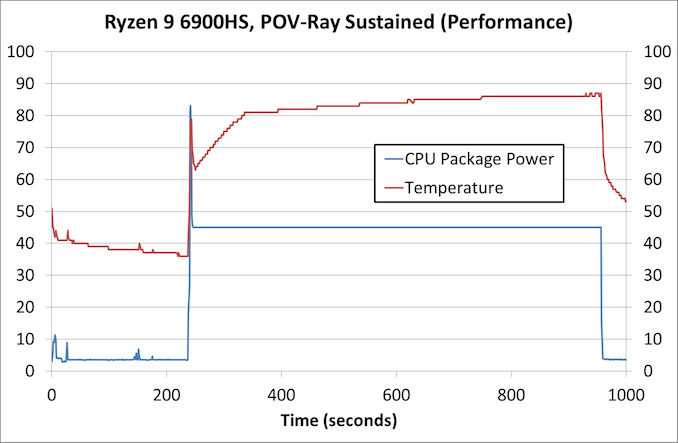
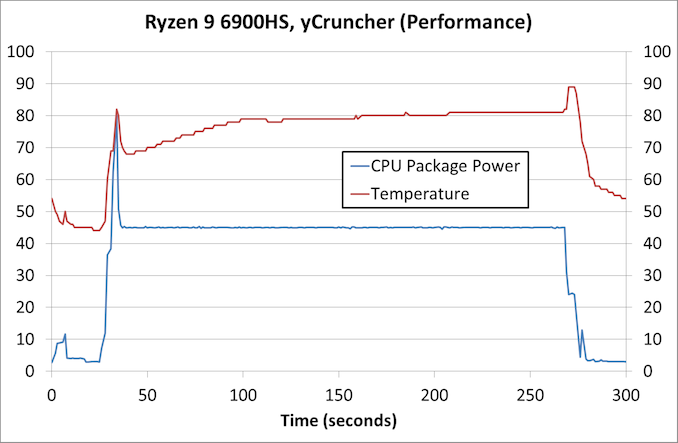
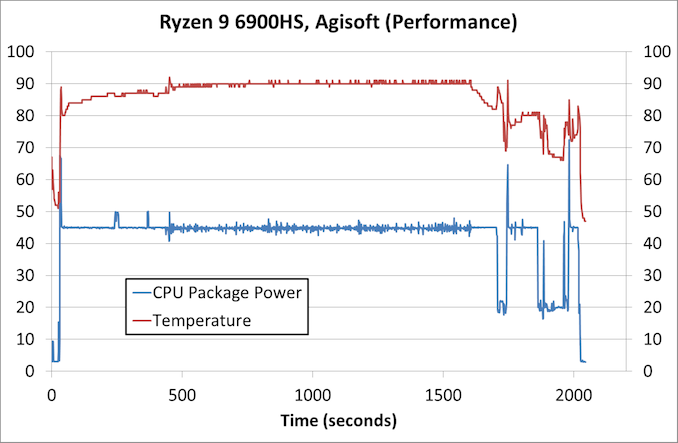

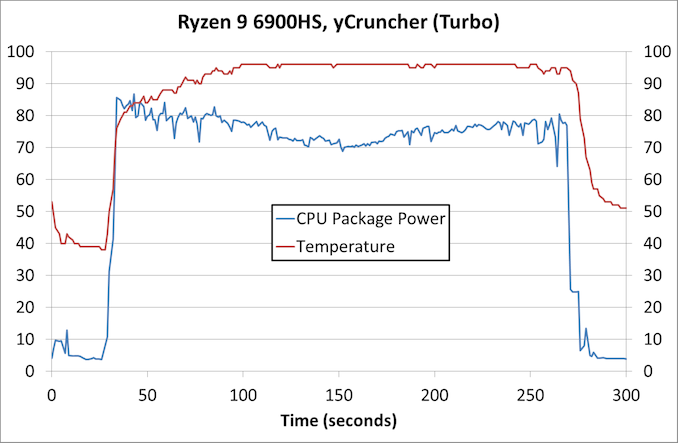
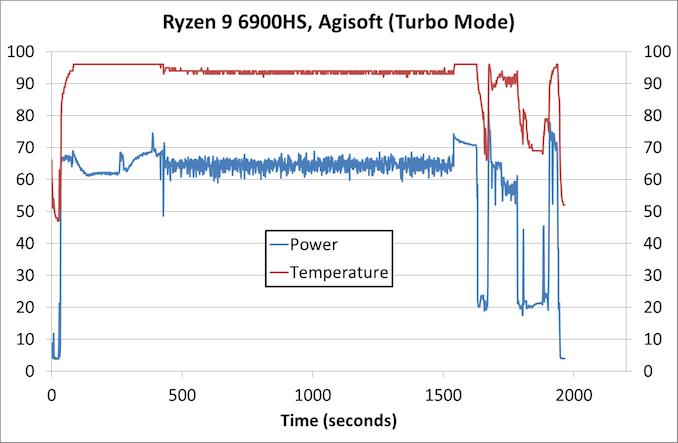
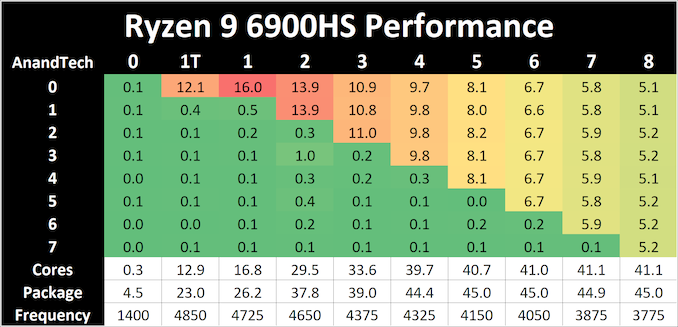
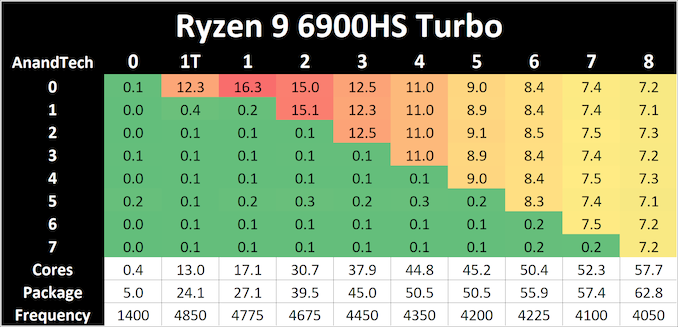









92 Comments
View All Comments
mode_13h - Sunday, March 13, 2022 - link
> M1 is cute, nothing more.Cool story bro. I guess the original M1 rather skimps on RAM. Maybe that's what's limiting your "first-hand experience".
Dug - Friday, March 11, 2022 - link
You don't know much about the architecture, do you?Marlin1975 - Tuesday, March 1, 2022 - link
From what I have seen Intel will hold the 45watt+ performance crown but the AMD 6000 series will do better at lower wattage.Fulljack - Tuesday, March 1, 2022 - link
not to mention the battery life. of course, if you're doing power consuming task like render, 4k video playback, or gaming, keep the device at wall power. but if you simply browsing, watching vids, or typing and doesn't need to use wall power continuously, the battery life are much much better than Alder Lake or Cezanne.yankeeDDL - Tuesday, March 1, 2022 - link
I have the same impression, but I did not see any solid data confirming this.trivik12 - Tuesday, March 1, 2022 - link
Rembrandt is a solid upgrade considering it was not a new cpu core. Still its good time to be a consumer. I hope anandtech reviews a 1280p laptops as well. That supposedly does very well at lower wattages as well.skavi - Tuesday, March 1, 2022 - link
The comparison I most want to see is the XPS 13 Plus with a 1280P up against the ThinkPad Z13 with a 6860Z. The ThinkPad looks like it may be the first AMD laptop in the same league as the XPS.skavi - Tuesday, March 1, 2022 - link
https://www.notebookcheck.net/Dell-XPS-13-Plus-932...https://www.notebookcheck.net/Lenovo-ThinkPad-Z13-...
Links for anyone interested.
DannyH246 - Tuesday, March 1, 2022 - link
"We haven't touched battery life or graphics" - the two areas where AMD completely destroys Intel. And arguably the 2 areas that most consumers will be bothered about. What a joke of an article.GoldenBullet - Tuesday, March 1, 2022 - link
Agreed, the igpu is amazing in ryzen 6000.